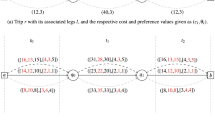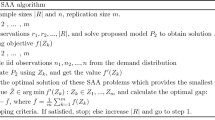Abstract
We study the problem of repositioning autonomous vehicles in a shared mobility system in order to simultaneously minimize the unsatisfied demand and the total operating cost. We first present a mixed integer linear programming formulation for the deterministic version of the problem. We extend this formulation to make it easier to work with in the non-deterministic setting. We then show how the travel time uncertainty can be incorporated into this extended deterministic formulation using chance-constraint programming. Finally, two new reformulations for the proposed chance-constraint program are developed. We show a critical result that the size of one of the reformulations (in terms of the number of variables and constraints) does not depend on the number of scenarios, and so it outperforms the other reformulation. Both reformulations are bi-objective mixed integer linear programs with a finite number of nondominated points and so they can be solved directly by algorithms such as the balanced box method (Boland et al. in INFORMS J Comput 27(4):735–754, 2015). A computational study demonstrates the efficacy of the proposed reformulations.










Similar content being viewed by others
References
Boland N, Charkhgard H, Savelsbergh M (2015) A criterion space search algorithm for biobjective integer programming: the balanced box method. INFORMS J Comput 27(4):735–754
Burns LD, Jordan WC, Scarborough BA (2013) Transforming personal mobility. Earth Inst. 431:432
Campi MC, Garatti S (2011) A sampling-and-discarding approach to chance-constrained optimization: feasibility and optimality. J Optim Theory Appl 148(2):257–280
Charnes A, Cooper WW (1959) Chance-constrained programming. Manag Sci 6(1):73–79
Chebbi O, Chaouachi J (2016) Reducing the wasted transportation capacity of personal rapid transit systems: an integrated model and multi-objective optimization approach. Transp Res Part E Logist Transp Rev 89:236–258
Dächert K, Gorski J, Klamroth K (2012) An augmented weighted tchebycheff method with adaptively chosen parameters for discrete bicriteria optimization problems. Comput Oper Res 39(12):2929–2943
de Almeida Correia GH, Antunes AP (2012) Optimization approach to depot location and trip selection in one-way carsharing systems. Transp Res Part E Logist Transp Rev 48(1):233–247
de Almeida Correia G, Santos R (2014) Optimizing the use of electric vehicles in a regional car rental fleet. Transp Res Rec J Transp Res Board 2454:76–83
Ecomobile (2018) http://www.ecomobile.gouv.qc.ca/en/ecomobilite/tips/idling_engine.php Last Accessed: 28-Jan-2018
Fagnant DJ, Kockelman K (2015) Preparing a nation for autonomous vehicles: opportunities, barriers and policy recommendations. Transp Res Part A Policy Pract 77:167–181
Fagnant DJ, Kockelman KM, Bansal P (2015) Operations of shared autonomous vehicle fleet for austin, texas, market. Transp Res Rec J Transp Res Board 2536:98–106
Gounaris CE, Wiesemann W, Floudas CA (2013) The robust capacitated vehicle routing problem under demand uncertainty. Oper Res 61(3):677–693
Jian S, Rey D, Dixit V (2016) Dynamic optimal vehicle relocation in carshare systems. Transp Res Rec J Transp Res Board 2567:1–9
Jorge D, de Almeida CG (2013) Carsharing systems demand estimation and defined operations: a literature review. Eur J Transp Infrastruct Res 13(3):201–220
Jorge D, Correia GH, Barnhart C (2014) Comparing optimal relocation operations with simulated relocation policies in one-way carsharing systems. IEEE Trans Intell Transp Syst 15(4):1667–1675
Jozefowiez N, Semet F, Talbi EG (2008) Multi-objective vehicle routing problems. Eur J Oper Res 189(2):293–309
Kek AG, Cheu RL, Meng Q, Fung CH (2009) A decision support system for vehicle relocation operations in carsharing systems. Transp Res Part E Logist Transp Rev 45(1):149–158
Klein Haneveld WK (1986) On integrated chance constraints. Springer, Berlin, pp 113–138
Lam AY, Leung YW, Chu X (2016) Autonomous-vehicle public transportation system: scheduling and admission control. IEEE Trans Intell Transp Syst 17(5):1210–1226
Laporte G, Louveaux F, Mercure H (1992) The vehicle routing problem with stochastic travel times. Transp Sci 26(3):161–170
Lees-Miller JD (2016) Minimising average passenger waiting time in personal rapid transit systems. Ann Oper Res 236(2):405–424
Liang X, de Almeida Correia GH, van Arem B (2016) Optimizing the service area and trip selection of an electric automated taxi system used for the last mile of train trips. Transp Res Part E Logist Transp Rev 93:115–129
Luedtke J, Ahmed S, Nemhauser GL (2010) An integer programming approach for linear programs with probabilistic constraints. Math Program 122(2):247–272
Maciejewski M, Bischoff J (2018) Congestion effects of autonomous taxi fleets. Transport 33(4):971–980. https://doi.org/10.3846/16484142.2017.1347827
Martin E, Shaheen S, Lidicker J (2010) Impact of carsharing on household vehicle holdings: results from north american shared-use vehicle survey. Transp Res Rec J Transp Res Board 2143:150–158
Pagnoncelli BK, Ahmed S, Shapiro A (2009) Sample average approximation method for chance constrained programming: theory and applications. J Optim Theory Appl 142(2):399–416
Pfrommer J, Warrington J, Schildbach G, Morari M (2014) Dynamic vehicle redistribution and online price incentives in shared mobility systems. IEEE Trans Intell Transp Syst 15(4):1567–1578
Shaheen S, Cohen A (2007) Growth in worldwide carsharing: an international comparison. Transp Res Rec J Transp Res Board 1992:81–89
Shaheen S, Cohen A, Roberts J (2006) Carsharing in north america: market growth, current developments, and future potential. Transp Res Rec J Transp Res Board 1986:116–124
Stidsen T, Andersen KA, Dammann B (2014) A branch and bound algorithm for a class of biobjective mixed integer programs. Manag Sci 60(4):1009–1032
Uber (2018) http://ot.to/. Last Accessed: 28-Jan-2018
Waymo (2018) https://waymo.com/ontheroad/. Last Accessed: 28-Jan-2018
Weikl S, Bogenberger K (2013) Relocation strategies and algorithms for free-floating car sharing systems. IEEE Intell Transp Syst Mag 5(4):100–111
Funding
No funding agency has supported this research.
Author information
Authors and Affiliations
Corresponding author
Ethics declarations
Conflict of interest
The authors declare that they have no conflict of interest.
Additional information
Publisher's Note
Springer Nature remains neutral with regard to jurisdictional claims in published maps and institutional affiliations.
Appendix
Appendix
In this section, we extend the results of Sect. 4.1. The imposed time limit is 3600 s. We solved each of the 20 small instances presented in Sect. 4.1 under three different settings including: 30, 60, and 90 scenarios denoted by S30, S60 and S90, respectively. The results are shown in Tables 5, 6 and 7 in which the maximum probability allowed for violating the uncertain constraints are different in these tables. Specifically, in Table 5, we set \(\alpha _{it}^k=0.1\) for each \(i\in \mathcal {N}\), \(t\in \mathcal {T}\backslash \{1\}\) and \(k\in \mathcal {M}\). In Table 6, we set \(\alpha _{it}^k=0.01\) for each \(i\in \mathcal {N}\), \(t\in \mathcal {T}\backslash \{1\}\) and \(k\in \mathcal {M}\). Finally, in Table 7, we set \(\alpha _{it}^k=0.001\) for each \(i\in \mathcal {N}\), \(t\in \mathcal {T}\backslash \{1\}\) and \(k\in \mathcal {M}\). Overall, we observe that for smaller maximum probability allowed for violating the uncertain constraints, both P5 and P6 can be solved faster but the number of nondominated points does not change.
Rights and permissions
About this article
Cite this article
Charkhgard, H., Takalloo, M. & Haider, Z. Bi-objective autonomous vehicle repositioning problem with travel time uncertainty. 4OR-Q J Oper Res 18, 477–505 (2020). https://doi.org/10.1007/s10288-019-00429-7
Received:
Revised:
Published:
Issue Date:
DOI: https://doi.org/10.1007/s10288-019-00429-7
Keywords
- Autonomous vehicle repositioning problem
- Bi-objective integer linear programming
- Chanced-constraint programming




